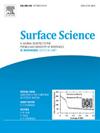通过取代掺杂可调单层二硫化钼的光学和电子特性
IF 1.8
4区 化学
Q3 CHEMISTRY, PHYSICAL
引用次数: 0
摘要
我们提出了一个全面的第一性原理研究在硫位点掺杂P块元素(B, C, N, O, Al, Si, P, Ga, Ge, As和Se)的单层MoS2的电子和光学性质。我们的计算表明,取代掺杂深刻地改变了能带结构,引入了局部或杂化的杂质态,这些杂质态可以减少、关闭或保持带隙,具体取决于掺杂物。值得注意的是,B、N、Al和Ga诱导了类似金属的行为,而O、C、Se和Si保持了半导体特性。态的部分密度分析表明,费米能级附近的态主要由Mo和S轨道控制,掺杂剂在调节主电子结构中起着关键的次要作用。光学性质计算表明,吸收和透明度在紫外光,可见光和红外区域依赖于掺杂剂的可调性。例如,Al掺杂增强了紫外吸收,而P掺杂改变了红外响应。值得注意的是,尽管结构和电子扰动,所有掺杂系统仍保持高可见透明度(>75%),强调了它们在光电和透明电子应用方面的潜力。这项工作建立了替代掺杂作为一种强大的策略,为下一代器件工程定制单层MoS2的电子和光学特性。本文章由计算机程序翻译,如有差异,请以英文原文为准。

Tunable optical and electronic properties of monolayer MoS2 via substitutional doping
We present a comprehensive first-principles investigation of the electronic and optical properties of monolayer MoS doped with p-block elements (B, C, N, O, Al, Si, P, Ga, Ge, As, and Se) at the sulfur site. Our calculations demonstrate that substitutional doping profoundly alters the band structure, introducing localized or hybridized impurity states that can reduce, close, or maintain the band gap, depending on the dopant. Notably, B, N, Al, and Ga induce metallic-like behavior, whereas O, C, Se, and Si preserve semiconducting characteristics. Partial density of states analysis reveals that states near the Fermi level are dominated by Mo and S orbitals, with dopants playing a critical secondary role in modulating the host electronic structure. Optical property calculations show dopant-dependent tunability of absorption and transparency across UV, visible, and infrared regions. For example, Al doping enhances UV absorption, while P doping modifies the infrared response. Remarkably, all doped systems retain high visible transparency (75%) despite structural and electronic perturbations, underscoring their potential for optoelectronic and transparent electronics applications. This work establishes substitutional doping as a powerful strategy for tailoring the electronic and optical properties of monolayer MoS for next-generation device engineering.
求助全文
通过发布文献求助,成功后即可免费获取论文全文。
去求助
来源期刊

Surface Science
化学-物理:凝聚态物理
CiteScore
3.30
自引率
5.30%
发文量
137
审稿时长
25 days
期刊介绍:
Surface Science is devoted to elucidating the fundamental aspects of chemistry and physics occurring at a wide range of surfaces and interfaces and to disseminating this knowledge fast. The journal welcomes a broad spectrum of topics, including but not limited to:
• model systems (e.g. in Ultra High Vacuum) under well-controlled reactive conditions
• nanoscale science and engineering, including manipulation of matter at the atomic/molecular scale and assembly phenomena
• reactivity of surfaces as related to various applied areas including heterogeneous catalysis, chemistry at electrified interfaces, and semiconductors functionalization
• phenomena at interfaces relevant to energy storage and conversion, and fuels production and utilization
• surface reactivity for environmental protection and pollution remediation
• interactions at surfaces of soft matter, including polymers and biomaterials.
Both experimental and theoretical work, including modeling, is within the scope of the journal. Work published in Surface Science reaches a wide readership, from chemistry and physics to biology and materials science and engineering, providing an excellent forum for cross-fertilization of ideas and broad dissemination of scientific discoveries.
 求助内容:
求助内容: 应助结果提醒方式:
应助结果提醒方式:


